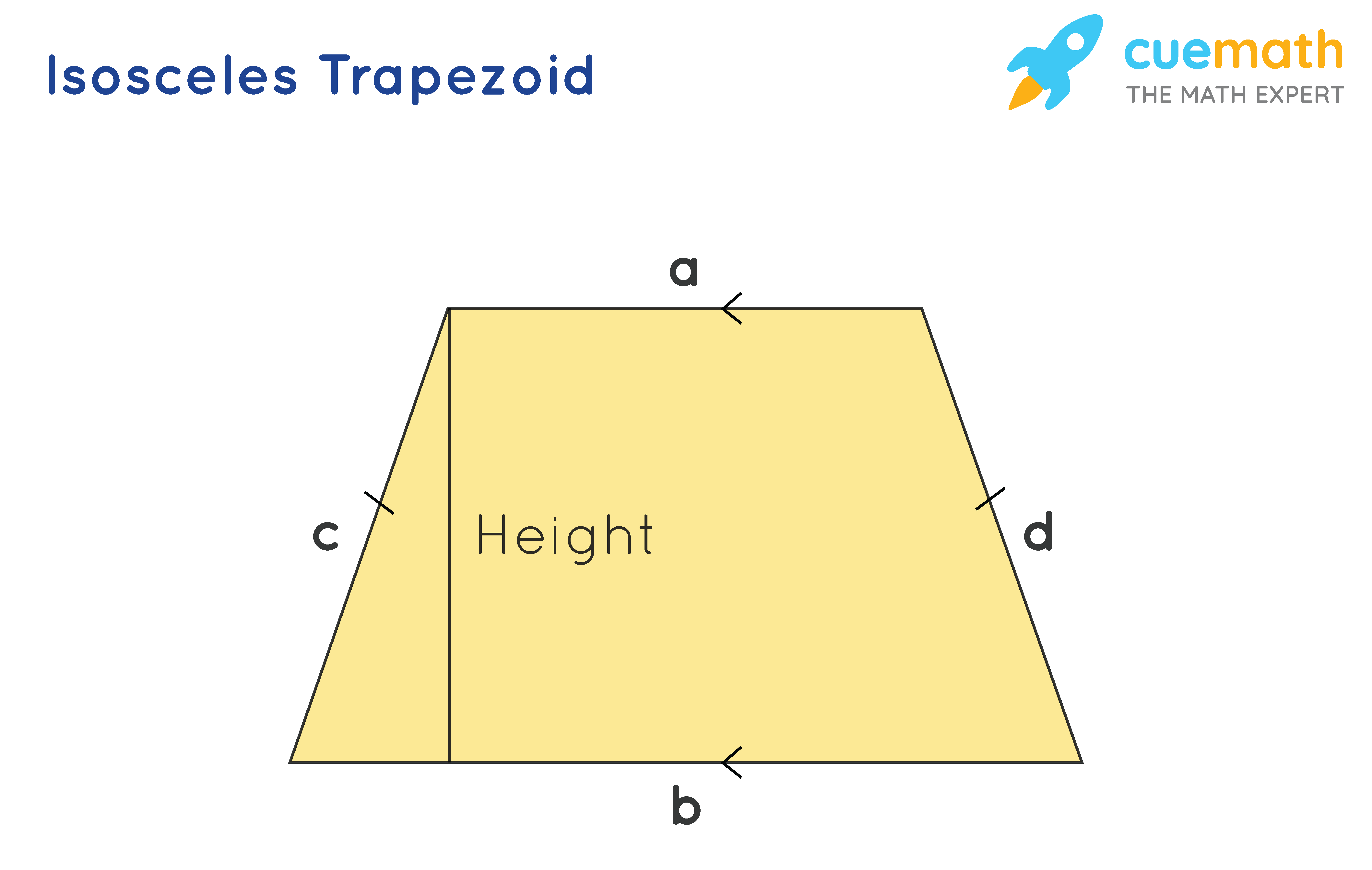Isosceles Trapezoid
An isosceles trapezoid is a trapezoid with congruent base angles and congruent non-parallel sides. A trapezoid is a quadrilateral with only one of its sides parallel. An isosceles trapezoid has many interesting properties that make it unique and help us differentiate it from the other quadrilaterals. Let us discuss them in detail.
| 1. | Isosceles Trapezoid Definition |
| 2. | Properties of Isosceles Trapezoid |
| 3. | Isosceles Trapezoid Formula |
| 4. | FAQs on Isosceles Trapezoid |
Isosceles Trapezoid Definition
An isosceles trapezoid can be defined as a trapezoid in which non-parallel sides and base angles are of the same measure. In other words, if two opposite sides (bases) of the trapezoid are parallel, and the two non-parallel sides are of equal lengths, then it is an isosceles trapezoid. Look at the image below-showing sides c and d are equal in lengths and opposite sides a and b (bases of the trapezoid) are parallel to each other.

Properties of Isosceles Trapezoid
Following are the properties of an isosceles trapezoid according to the figure given below.

- It has an axis of symmetry. It has no rotational symmetry and one line of symmetry joining the midpoint of the parallel sides.
- One pair of sides is parallel and they are the base sides. (AB II DC in the given image)
- The remaining sides other than the base are non-parallel and are equal in length. (c = d in the given image)
- The diagonals are the same in length. (AC = BD)
- The base angles are the same. (∠D = ∠C, ∠A=∠B)
- The sum of opposite angles is 180° or supplementary. (∠A + ∠C = 180° and ∠B + ∠D = 180°)
- The line segment joining the midpoints of the parallel sides is perpendicular to the bases. (PQ ⊥ DC)
Isosceles Trapezoid Formula
Following are the formulas to calculate the area and perimeter of the isosceles trapezoid.
Area of isosceles trapezoid
To find the area of the isosceles trapezoid we have to add the base sides or parallel sides and divide it by 2 and then multiply the result with height.
Area of Isosceles Trapezoid = (sum of parallel sides ÷ 2) × h
Perimeter of isosceles trapezoid
To find the perimeter of the isosceles trapezoid we have to add all the sides of the isosceles trapezoid.
Perimeter of Isosceles Trapezoid = sum of all sides

Related Articles on Isosceles Trapezoid
Check out the interesting topics to learn more about the Isosceles Trapezoid.
Examples on Isosceles Trapezoid
-
Example 1: Find the height of the isosceles trapezoid if the area is 128 inches2 and the lengths of the bases are 12 inches and 20 inches.
Solution: Given area = 128 inches2 , Bases = 12 inches and 20 inches
we know that area of isosceles trapezoid = (sum of parallel sides ÷ 2) × height
therefore, 128 = [(12 + 20) ÷ 2] × height
Height = 128/16 = 8 inches -
Example 2: Find the area of an isosceles trapezoid if its bases are 3 inches and 5 inches and its height is 4 inches.
Solution: Area of isosceles trapezoid = (sum of parallel sides ÷ 2) × height
given, bases = 3 inches and 5 inches, height = 4 inches
Area = [(3 + 5) ÷ 2] × 4
Area = 16 inches2 -
Example 3: Find the perimeter of an isosceles trapezoid if its bases are 20 inches and 25 inches and non-parallel sides are 30 inches each.
Solution: Perimeter of an isosceles trapezoid = sum of all sides of isosceles trapezoid
Perimeter of an isosceles trapezoid = 20 + 25 + 30 + 30 = 105 inches

FAQs on Isosceles Trapezoid
What is an Isosceles Trapezoid?
An isosceles trapezoid is a type of trapezoid that has nonparallel sides equal to each other. An isosceles trapezoid is a type of quadrilateral where the line of symmetry bisects one pair of the opposite sides. The bases of an isosceles trapezoid are parallel to each other along with the legs being equal in measure.
What are the Properties of an Isosceles Trapezoid?
In an isosceles trapezoid, the number of sides is four. The two opposite sides (bases) are parallel to each other and the other two sides are equal in lengths but non-parallel to each other.
If One Base Angle of Isosceles Trapezoid is 30°. Find the Other Base Angle.
According to the property of an isosceles trapezoid, the base angles are equal, therefore if one base angle is 30°, then the other base angle will be equal to 30°.
What is the Difference Between a Trapezoid and an Isosceles Trapezoid?
In a trapezoid, each side is of different lengths and the diagonals are not congruent, whereas, in an isosceles trapezoid the non-parallel sides are equal, the base angles are equal, the diagonals are congruent and the opposite angles are supplementary.
What is the Formula for Area of an Isosceles Trapezoid?
The formula to calculate the area of an isosceles trapezoid is Area = (sum of parallel sides ÷ 2) × height.
What is the Formula for Perimeter of an Isosceles Trapezoid?
The formula to calculate the perimeter of an isosceles trapezoid is Perimeter = sum of all sides of the isosceles trapezoid
visual curriculum